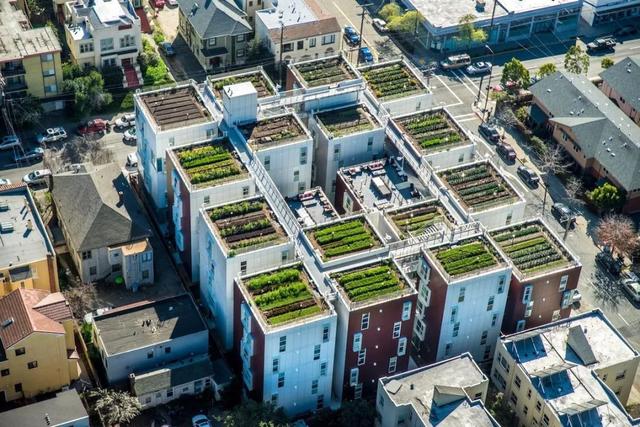
(本文选自《经济学人》20200704期)
背景介绍:
新加坡是位于东南亚的一个岛国,国土面积仅为720平方公里。而作为农田的土地面积更是少得可怜,如今仅为国土面积的不到1%(即大约不到7平方公里)。由于土地资源有限,新加坡的粮食大多靠进口。但如今,随着疫情大流行,全球粮食供应也受到了影响,于是新加坡的农民纷纷开始在屋顶种起菜来。
The rise of the rooftop farmer
越来越多人在屋顶种菜
Government subsidies make excellent fertiliser
政府补贴成为了最好的肥料
Benjamin Swan’s farm is on the fourth floor of an office building in an industrial part of Singapore. To see his crops, visitors are escorted past a door unlocked with a thumbprint and through an airlock. (“Our air is certified,” says an assistant.) Room after room is filled with plumes of kale and lettuce, evenly spaced on long trays stacked in floor-to-ceiling racks.
本杰明·斯旺的农场位于新加坡工业区一幢办公楼的四楼。想要看看他的庄家,参观者必须通过一扇装有指纹锁的大门以及一道气闸室。(一位助理说:“内部空气已经过认证。”)一间间房里种满了羽衣甘蓝和生菜,它们均匀地生长在长长的托盘里,架子上的一个个托盘从地面一直堆叠至天花板。
Cables snake across the racks and ceilings, like an electrical root system. LED lights, designed to emit only the part of the electromagnetic spectrum that plants can absorb, cast a purple glow. The greens are planted in a substrate—not a speck of soil is in sight.
电线蜿蜒曲折地穿过架子和天花板,仿佛电子根系一般。经设计的LED灯仅会发出植物所能吸收的那部分电磁波谱,即紫色的微光。绿色植物被种植在看不到一丁点土壤的基质中。
Singapore is a hymn to concrete and metal. But look closely and you can see farms mushrooming across the city-state: on the roofs of malls and car parks, in schools, warehouses and even the site of a former prison. This is new.
新加坡是一首钢筋混凝土的赞歌。但你仔细观察便会发现,城市中的农场正如雨后春笋般涌现:在商场和停车场的屋顶、在学校、在仓库,甚至在废弃的监狱里。这一景象是前所未有的。
Commercial farming in the land-scarce city was phased out in the 1970s and 1980s. “Unlike virtually any other country on earth, Singapore has lost a generation of farmers,” says Bradley Busetto of the Global Centre for Technology, Innovation and Sustainable Agriculture, a UN outfit based in Singapore.
20世纪70年代和80年代,商业农业逐渐被土地稀缺的城市所淘汰。全球技术、创新与可持续农业中心(一家总部位于新加坡的联合国机构)的布拉德利·布塞托说:“不同于世界其他国家,新加坡已经失去了一代农民。”
Today just 720 square kilometres of land, less than 1% of Singapore, is set aside for farms. But a new crop of entrepreneurs are betting on rewards from finding idle spaces where lettuces may be coaxed to life. Since 2014, 31 commercial urban farms have sprouted.
如今,在新加坡720平方公里的国土面积中,仅有不到1%的土地被用作农田。但是,一批新的企业家正将赌注押在了可用于培育生菜的闲置空间上。自2014年以来,全国已经涌现出31家城市商业农场。
The government is delighted. Singapore imports more than 90% of its food. It is “extremely vulnerable to fluctuations in our food availability that may be brought about by climate change, disease outbreaks and global food situations,” says Low Li Ping of the Singapore Food Agency. In 2019 the government said the country should produce 30% of its food by 2030.
政府对此也很乐见。在新加坡,超过90%的粮食靠进口。新加坡粮食署的洛李平说:“气候变化、疾病爆发以及全球粮食形势极易对我国的粮食供应造成影响。”2019年,新加坡政府表示,到2030年,国内粮食产量将占粮食需求总量的30%。
It has put its money where its mouth is. Before the pandemic the government had pledged S$207m ($149m) to help farmers boost productivity and to spur research. In April the government, spooked by the pandemic’s (small) disruptions to global markets for food, promised an extra S$30m to help farmers grow more in the next six to 24 months, and invited urban farmers to apply to rent the roofs of nine government-owned car parks. Mr Swan, the indoor kale farmer, credits the government with helping to fund his company’s R&D and introducing him to investors.
政府已经兑现了承诺。在新冠疫情爆发前,政府承诺向农民提供2.07亿新元(合1.49亿美元),以帮助农民提高生产力并推动农业相关研究。今年4月,出于对全球粮食市场受疫情影响(虽然影响甚微)的恐慌,政府承诺将在未来6至24个月内额外提供3000万新元,以帮助农民种植更多作物,并且鼓励城市农民申请租用9个归政府所有的停车场的屋顶。室内羽衣甘蓝种植者斯旺表达了对政府的感谢,政府为他的公司提供了研发资金,并为他介绍了一些投资者。
Such help is gratefully received. Farming in the city can be expensive. Property and labour are costly. To maximise space, farmers stack plants. Some go inside, which means losing a free and plentiful input—the sun—but allows greater control of the environment. “Every room is its own climate,” says Sven Yeo of Archisen, an indoor farm that tinkers with temperature, humidity, carbon dioxide, light, water and nutrients to produce tastier lettuce, sorrel and chard.
人们欣然接受了政府的资助。城市里种地成本高昂,土地和劳动力都很昂贵。为了能够最大限度地利用空间,农民们会将作物堆叠种植。一些农场走进了室内,室内农场意味着免费而充足的阳光将不复存在,但这样一来能够更好地控制环境条件。室内农场阿奇森通过调节温度、湿度、二氧化碳含量、光照、水分和营养来生产更美味的生菜、酸模和甜菜。阿奇森的斯旺·约说:“每个房间都有自己的气候。”
The technology does not come cheap, but it does allow for more frequent and bountiful harvests. Mr Swan says his farm yields 178 times more lettuce per square metre than a traditional one. It started production in 2015 and broke even for the first time in 2018. His labours are bearing fruit.
这项技术并不便宜,但确实能够促进作物的生长并提高收成。斯旺说,他的农场每平方米的生菜产量比传统农场高178倍。自2015年投入生产以来,2018年首次实现了盈亏平衡。他的努力正在结出硕果。
重难点词汇:
escort [ˈeskɔːrt] vt. 护送;陪同
hymn [hɪm] n. 赞美诗;赞歌
mushroom [ˈmʌʃrʊm] n. 蘑菇;暴发户 v. 迅速增加
coax [koʊks] v. 哄骗;劝诱
sprout [spraʊt] v. 发芽;长芽
fluctuation [ˌflʌktʃuˈeɪʃn] n. 起伏;波动
disruption [dɪsˈrʌpʃn] n. 扰乱;打乱;中断
bountiful [ˈbaʊntɪfl] adj. 丰富的;慷慨的
立足亚洲 面向世界
传递论坛最新动态 促进亚洲深度合作
全球重要对话的传达者 亚洲共同发展的瞭望者